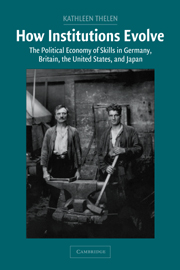 How Institutions Evolve
How Institutions Evolve Published online by Cambridge University Press: 05 September 2012
Previous chapters have focused primarily on explaining variations across the four countries that are the subject of this study, and have traced the roots of important differences in vocational training institutions back to the political dynamics and coalitions that were forged around the turn of the century and into the 1920s. This chapter takes up the German case again and tracks its further development through National Socialism and into the post-World War II period. This involves a shift in focus, away from the origins of cross-national differences to variations over time within a single country. This shift allows us to address a related but distinct set of questions and theoretical issues concerning institutional stability and change.
As discussed in Chapter 1, the most commonly invoked metaphor for institutional change is the punctuated equilibrium model as it was adapted from the work of evolutionary biologists and interpreted for politics by Krasner in 1988 (Krasner 1988). This model emphasizes long stretches of institutional “stasis” periodically punctuated by episodes of relatively rapid innovation. In most treatments, innovation occurs as a result of some kind of exogenous shock that disrupts the stable reproduction of institutions and provides an opening for substantial institutional reconfiguration. This view of political and institutional change is pervasive, finding expression in a good deal of the literature on “critical junctures” as well as some treatments of path dependence. This kind of model captures one important mode of change in political life.
To save this book to your Kindle, first ensure [email protected] is added to your Approved Personal Document E-mail List under your Personal Document Settings on the Manage Your Content and Devices page of your Amazon account. Then enter the ‘name’ part of your Kindle email address below. Find out more about saving to your Kindle.
Note you can select to save to either the @free.kindle.com or @kindle.com variations. ‘@free.kindle.com’ emails are free but can only be saved to your device when it is connected to wi-fi. ‘@kindle.com’ emails can be delivered even when you are not connected to wi-fi, but note that service fees apply.
Find out more about the Kindle Personal Document Service.
To save content items to your account, please confirm that you agree to abide by our usage policies. If this is the first time you use this feature, you will be asked to authorise Cambridge Core to connect with your account. Find out more about saving content to Dropbox.
To save content items to your account, please confirm that you agree to abide by our usage policies. If this is the first time you use this feature, you will be asked to authorise Cambridge Core to connect with your account. Find out more about saving content to Google Drive.